The Intel 6th Gen Skylake Review: Core i7-6700K and i5-6600K Tested
by Ian Cutress on August 5, 2015 8:00 AM ESTWhat You Can Buy: Linux Performance
Built around several freely available benchmarks for Linux, Linux-Bench is a project spearheaded by Patrick at ServeTheHome to streamline about a dozen of these tests in a single neat package run via a set of three commands using an Ubuntu 11.04 LiveCD. These tests include fluid dynamics used by NASA, ray-tracing, OpenSSL, molecular modeling, and a scalable data structure server for web deployments. We run Linux-Bench and have chosen to report a select few of the tests that rely on CPU and DRAM speed.
C-Ray: link
C-Ray is a simple ray-tracing program that focuses almost exclusively on processor performance rather than DRAM access. The test in Linux-Bench renders a heavy complex scene offering a large scalable scenario.
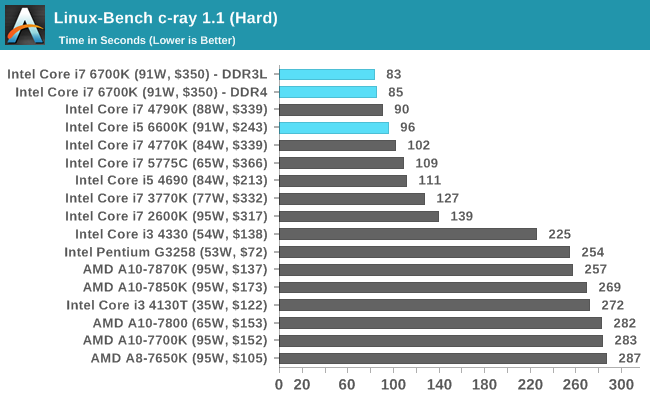
NAMD, Scalable Molecular Dynamics: link
Developed by the Theoretical and Computational Biophysics Group at the University of Illinois at Urbana-Champaign, NAMD is a set of parallel molecular dynamics codes for extreme parallelization up to and beyond 200,000 cores. The reference paper detailing NAMD has over 4000 citations, and our testing runs a small simulation where the calculation steps per unit time is the output vector.
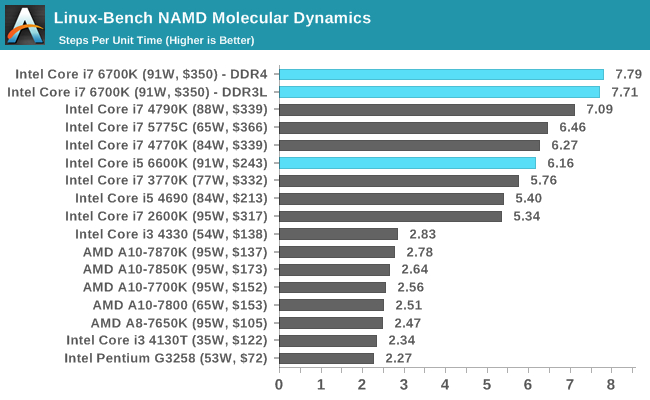
NPB, Fluid Dynamics: link
Aside from LINPACK, there are many other ways to benchmark supercomputers in terms of how effective they are for various types of mathematical processes. The NAS Parallel Benchmarks (NPB) are a set of small programs originally designed for NASA to test their supercomputers in terms of fluid dynamics simulations, useful for airflow reactions and design.
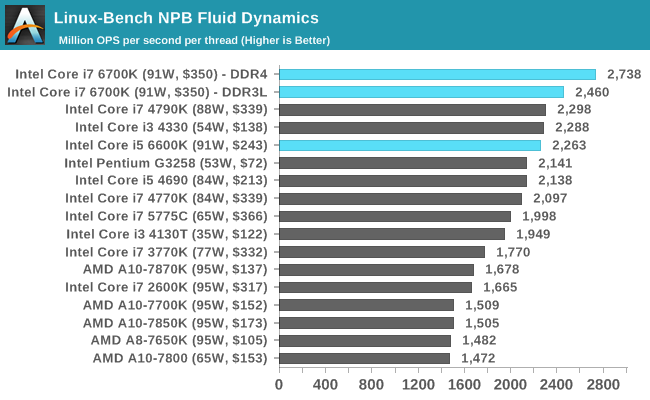
Redis: link
Many of the online applications rely on key-value caches and data structure servers to operate. Redis is an open-source, scalable web technology with a b developer base, but also relies heavily on memory bandwidth as well as CPU performance.
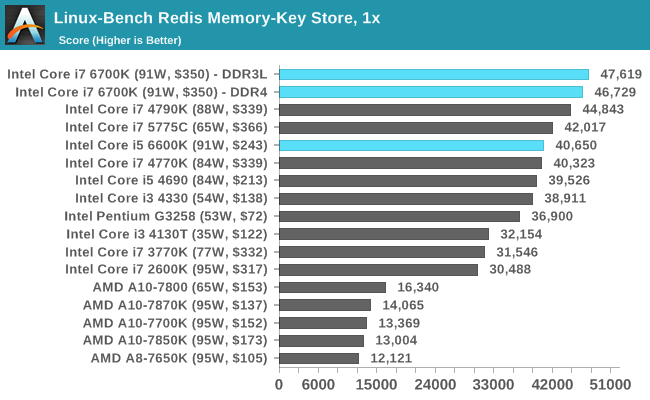
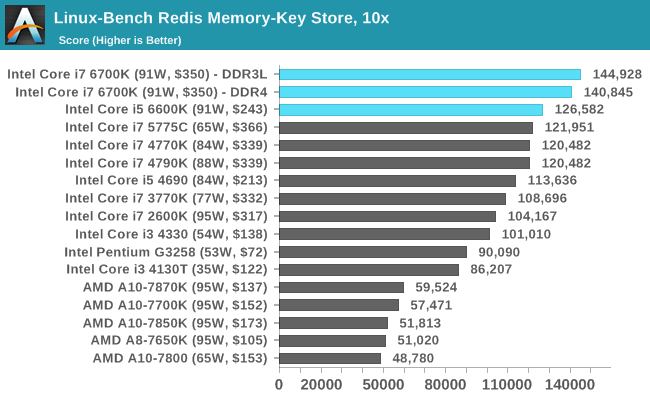
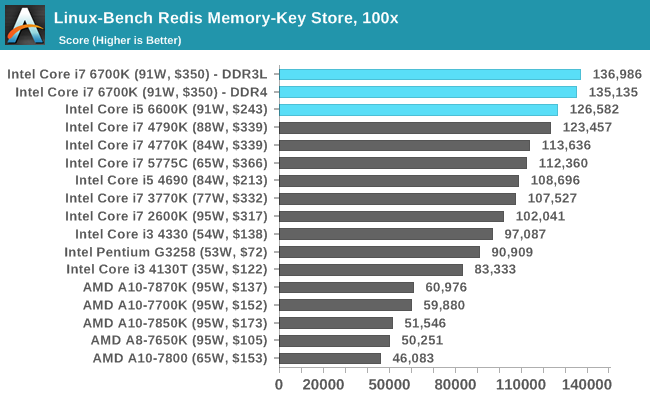










477 Comments
View All Comments
ES_Revenge - Friday, August 14, 2015 - link
Umm what the heck happened to the power consumption? In particular the i7/6700K. It's not really shown thoroughly in this review but the Broadwell CPUs are more power-efficient it seems. While the 6700K has a half GHz faster clock speed, it also has a much lesser GPU. To begin with, both the i5 and i7 Skylake parts have higher TDPs than the Broadwell desktop parts, and then the 6700K can actually draw over 100W when loaded. This is above its TDP and also significantly more than its 6600K counterpart which runs only a few hundred MHz slower. Odd.I mean I think we were all waiting for a desktop CPU that didn't have the power constraints as the Broadwell CPUs did but I don't think this is exactly what anyone was expecting. It's like these Skylake CPUs don't just take more power but they do so...for no reason at all. Sure they're faster but not hugely so; and, again, their iGPUs are significantly slower than Broadwell's. So their slight speed advantage came at the price of markedly increased power consumption over the previous gen.
That only leads me to the question--WTF? lol What happened here with the power consumption? And losing that IVR didn't seem to help anything, eh? Skylake is fast and all but TBH I was more impressed *overall* with Broadwell (and those CPUs you can't even find for sale anywhere, the last time I checked--a few weeks ago). Granted as we've seen in 2nd part of the Broadwell review it's not a stellar OCer but still, overall it seems better to me than Skylake.
It's kind of funny because when Broadwell DT launched I was thinking of how "Intel is mainly focusing on power consumption these days", meaning I thought they weren't focused enough on performance of DT CPUs. But it seems they've just thrown that out the window but the performance isn't anything *spectacular* from these CPUs, so it just seems like a step backwards. It's like with Broadwell they were showing just how much performance they could do with both CPU and iGPU with a minimum of power consumption--and the result was impressive. Here it's like they just forgot about that and said "It's Skylake...it's new and better! Everyone buy it!" Not really that impressive.
janolsen - Friday, August 14, 2015 - link
Stupid question:Can Skylake IGP easily play back 4K video. Thinking of a person just using a 4K screen for Youtube stuff, not gaming...
ES_Revenge - Saturday, August 15, 2015 - link
Yeah it can. This one of the very few improvements over Broadwell/previous HD Graphics implementations. It has a "full" HEVC decode solution built in, unlike the "hybrid" solutions they had previously. If you look on the 4th page of the review it actually goes pretty in-depth about this (not sure how you missed that?).alacard - Friday, August 14, 2015 - link
It's clear you put a ton of work into this Ian, many thanks.Flash13 - Monday, August 17, 2015 - link
So, far Intel Core i7-6700K 8M Skylake Quad-Core 4.0GHz is just vapor to the public.somatzu - Wednesday, August 19, 2015 - link
"So where'd you get your degree?""Anandtech comments section."
superjim - Friday, August 21, 2015 - link
I'm still not convinced this is a worthwhile upgrade from Sandy Bridge. If I can get 4.8 from a 2700K and maybe 4.6 from a 6700k, factor in cost difference, is it really worth it? At the end of the day, cpu/mobo/ram would be near $700 for maybe a 15% speed bump overall.watzupken - Friday, September 4, 2015 - link
From a desktop standpoint, there is very little incentive for one to upgrade. The new gen mainly targets power savings, so likely to benefit mobile users, i.e. Ultra Books and tablets.As far as Intel is trying to target those people still on Sandy and Ivy Bridge to upgrade, they fail to account for the cost of upgrade for a paltry improvement in performance. To upgrade from SB, one has to upgrade the ram, motherboard and CPU, and on top of that, need to separately purchase a heatsink since they want to cut cost.
CynicalCyanide - Saturday, August 22, 2015 - link
Question to the Authors: You've noted two DDR4 equipped mobos in the "Test Setup" section, but you've also tested DDR3 equipped Skylake. Which motherboard did you use for that?Furthermore, in a previous article it was mentioned that Z170 wouldn't be able to handle 'regular' 1.5V DDR3, but here apparently it wasn't an issue reusing old 1.5V RAM after a voltage adjustment. Was there any special method required aside from booting as per normal into the BIOS and adjusting the voltage?
TiberiuC - Saturday, August 22, 2015 - link
Everything comes down eventualy to "Intel vs AMD". What Intel did with Core2Duo was the right path to go, what AMD did was so wrong and that sometimes happen when you inovate. AMD stopped with the last FX series and went back to the drawing board and that is a wise decision. What will ZEN do? i am expecting Ivi Bridge performance maybe touching haswell here and there. If this wont happen, it is bad for them and very bad for us. Intel is starting to milk the customers acting like there is a monopoly. I did buy my 2600k for 300$ (after rebates), i have to say that the price of the 6700k is well, meh...